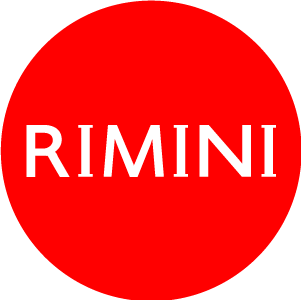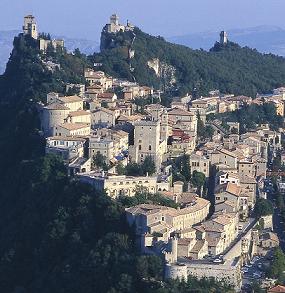
Guida pratica
San Marino
by car: take the Rimini - San Marino Superstrada, 24km, to Borgo Città.
After parking in Borgomaggiore you may use the cableway which transports you to the Fortresses in just a few minutes.
by bus:Bonelli (0541- 662069) and Fratelli Benedettini bus lines (Tel: 0549-903854) offer service from Rimini beach area (in summer) and from the railway station in Rimini (all year). Find information here
by bike: We suggest the following routes, all starting from Rimini:
1) Superstrada for Cerasolo - Dogana - Domagnano - Borgomaggiore.
No difficulty until Dogana, then medium difficulty until San Marino City.
Should take about 45 minutes.
2) Marecchiese Road until Torello di San Leo, then Acquaviva - Borgomaggiore.
No difficulty until Gualdicciolo, then somewhat difficult until Borgomaggiore.
3) Villaggio I Maggio - Ospedaletto - San Patrignano - Torraccia - Domagnano - San Marino.
Flat terrain until Ospedaletto, then medium difficulty.
4) Coriano - Croce - Mercatino Conca - Montelicciano - San Marino.
Flat until Mercatino, then medium difficulty until Fiorentino.
The ancient towers of freedom
According to historical traditions the ancient Republic of San Marino was founded by a Dalmation stone-cutter, Marinus, who had been commissioned by Diocletian to restore the city walls of Rimini.
Marinus and his collegue and friend Leone were Christians and, in order to escape the Emperor's persecution, one took refuge on Mount Feretrio and the other on Mount Titano. Marinus is described in a 10th century manuscript as the "libertatis fundator" of the tiny Republic.
In fact, San Marino's land area measures 61 square kilometres.
After about ten kilometres uphill, you are at the bottom of Monte Titano, in the ancient Borgo Maggiore, the old Mercatale which conserved through the years the old tracks of the council squares of the XIII century. A cable car offers a comfortable service, leaving each 15 minutes, and it allows to reach, only by two minutes, to the heart of the capital, San Marino, sweetly lying on Monte Titano (mt. 750 slm).
The historical centre, inside fortified walls, offers to the visitor the opportunity of an interesting tour among the characteristic quarters belonging to far away times, many scenic corners and glimpses of landscapes carrying an incomparable beauty, paths ending up to reach to the three medieval towers. These were built by the habitants of San Marino as a valid system of fortification, linked to each others in order to keep forever their Freedom, which observes the beautiful valley below from the top of Monte Titano. From the fortresses, the visitor’s eyes glimpse a suggestive landscape, full of different shades: as a frame, the sweet mounts of Appennino Tosco-Emiliano which gradually descend up to the Adriatic coast.
In the heart of the historical centre, in Piazza della Libertà, there is the Palazzo Pubblico, headquarters of the Big Council and the Parliament. Rebuilt in a neo-gothic style at the end of the XIX century, the inauguration speech was claimed by Giosuè Carducci,
Leaving Piazza della Libertà, a little climb leads to Basilica del Santo, in a neo-classical style, belonging to the XIX century. The interior, made up by three naves and seven altars, is rich thanks to all the priceless statues and paintings. The more important altair, by Tadolini, hosts the statue and the urn containing San Martino’s bones.
Next to the Basilica, there is the San Pietro Church, next to which there still are the stairs and the beds dig in the stone by Saints Martino and Leo.
An habitat and a landscape which carry aesthetic qualities, so special that it was claimed Patrimony of the Humanity by the Unesco. Independent since the XIII century, San Marino is “the only city-state which survives still nowadays as an excellent testimony of the foundation of a representative democracy based on the autonomy and the self-government."
The history of San Marino is amazing and unique and it is reflected in an original institutional system, becoming somehow an exemplum: the Chiefs of the State are two and keep their role for six months only, in order not to use their power to get privileges.
Suggestive tradition and ceremonies, which have never changed through the times, get back to life on the occasion of the most important festivals: every year, on 1st April and 1st October, San Marino celebrates the entrance of the Regent Captains, the two chiefs of the state which are going to govern during the following months, with a really suggestive ceremony which has been taking place for ages following an old protocol. The 3rd September is both the Patron Saint and the anniversary of the Foundation of the Republic, and it is celebrated with a big popular festival in which the old traditions are recalled, such as the quarrel of Palio delle Balestri Grandi.
Typical cuisine: In areas that attract many tourists, and San Marino is one of these areas, international dishes meant to satisfy any palate have replaced the typical cuisine.
On Mount Titano, however, one can find dishes offering a taste of the authentic flavours of Romagna, from cassoni to tagliatelle, as well as various types of roast meat.
Among the typical desserts is the Tre Monti cake, with its crust that is firm and at the same time crumbly. Other typical desserts include casciatello, made with milk, sugar, eggs and lemon, and bustrengo.
Wines: In the Republic, so close to Romagna, a wide range of red, white and sparkling wines are produced. Light, fresh Biancame or Ribolla exemplify the white wines. The red wines come from Sangiovese and are known locally as Brugneto di San Marino.
Brugneto is a good wine which reaches the highest levels of quality in the Reserve version. Moscato, usually drunk with desserts, is similar to the Asti Spumante produced in Piedmont and is vivacious, sweet and very pleasant.
These wines are all sold and protected by the San Marino Consortium of typical wines. The "Identificazione d'Origine" seal of quality safeguards and develops San Marino's wine production.
Purchases and souvenirs: Visitors can find gold and embossed silver jewelry in San Marino's many authorized jewelry shops.
Collector's coins and stamps can also be found at the Azienda Autonoma di Stato di Numismatica e Filatelia. The coins are categorized by type: Ordinary, which can be spent in Italy, Silver, which are only commemorative, and gold scudi which can only be spent in San Marino.
A look around:
The Republic of San Marino is divided in nine Castles: the first among them is Castello di Città, on the top of Monte Titano, which represents the most ancient nucleus.
It is possible, in the Castello of Serravalle, to reach the top of the rock and, in Borgomaggiore, to admire the Sanctum designed by Michelucci.
Each castle offers some curiosities or ancient remains; for example, an old castle, mostly built on a Malatestian fortress, has been restructured in Montegiardino.
Monte Titano offers to the visitors some beautiful parks and pine forests, for example in Montecerreti, Montecchio and the life tour in Domagnano.
In the Museo dellEmigrante, the ancient monastery of Santa Chiara (tel. 0549/885171), through an interesting collection of documents and images, it is told an important page of San Marino history.
The Atomic Hourglass, in Eugippo street, comes back to life every time any atomic bomb gets deactivated.
The tourist offer was able to complete and make richer the natural appeal of the area, thanks to a well-structured opportunity of shopping, hospitality, fun moments, cultural events,
Naturalistic tours in an uncontaminated environment joined the urban ones.
Even the sporty structures are not missed and in the sky the ultra-light planes are on hand for amazing and scenic flights.

©2016-2023 Assessorato al turismo / Comune di Rimini, Piazzale Fellini 3 47921 - Rimini - +39 0541 704587 / Ufficio Informazioni Turistiche (IAT) +39 0541 53399 / fax +39 0541 56598 / Statistiche web


